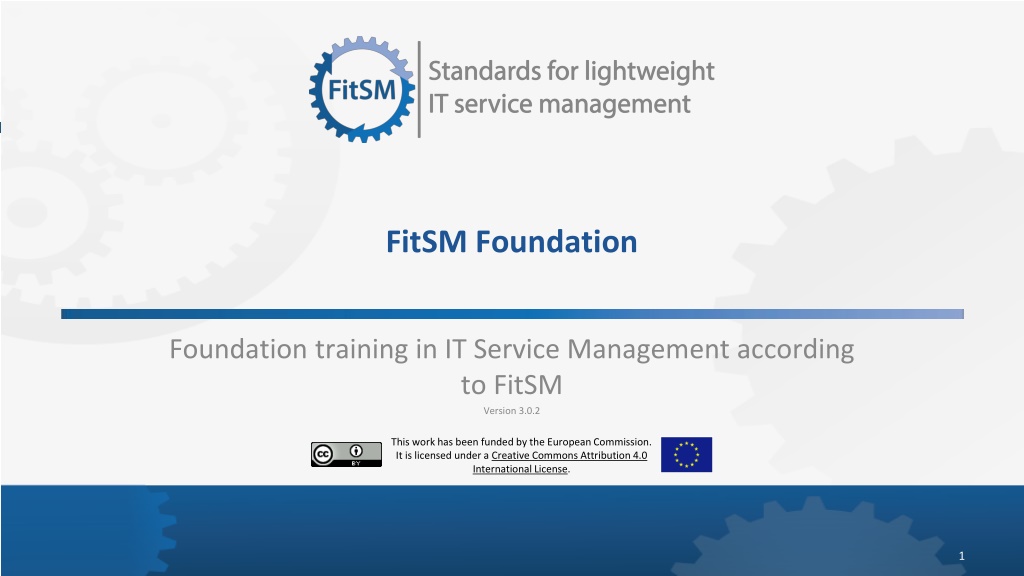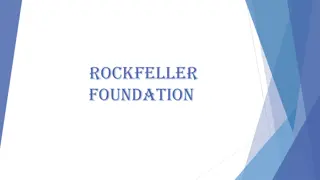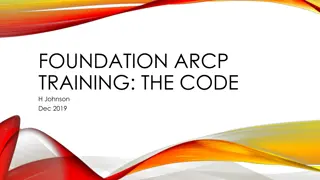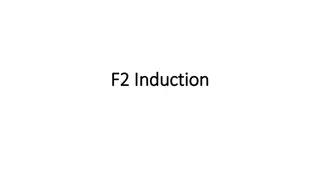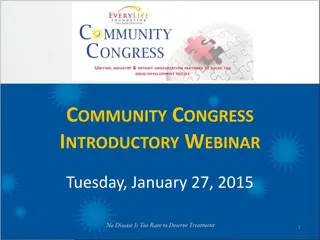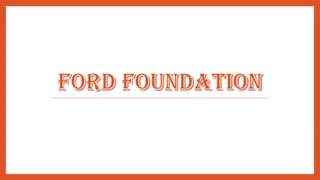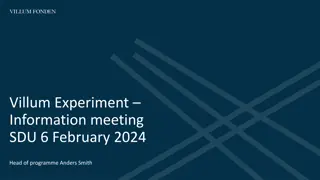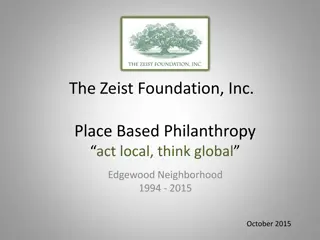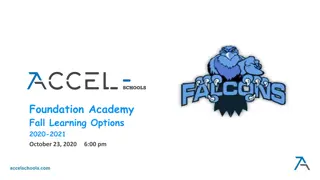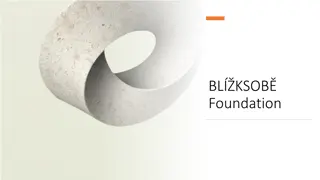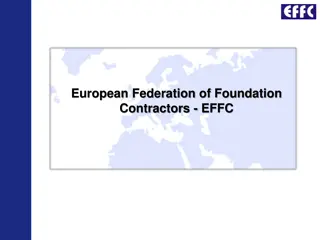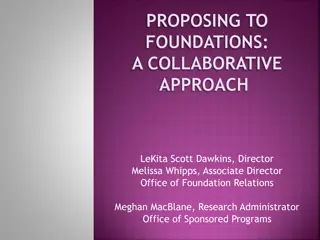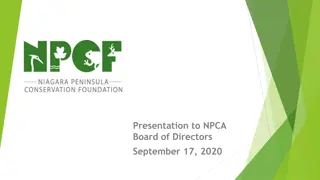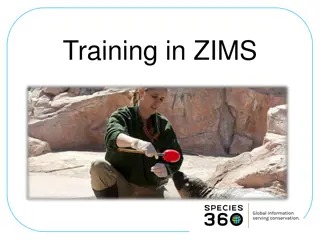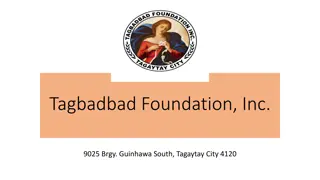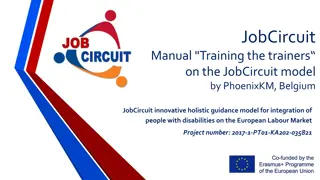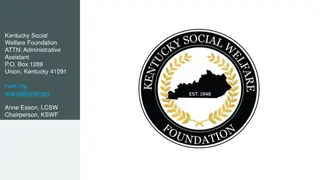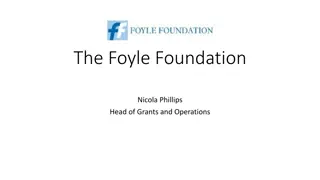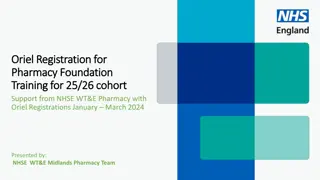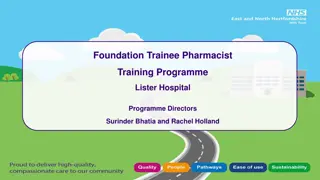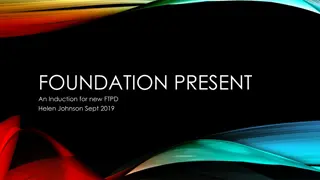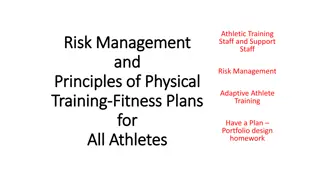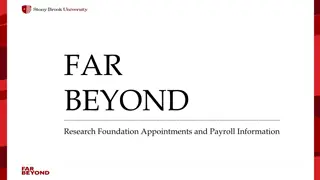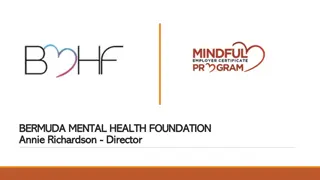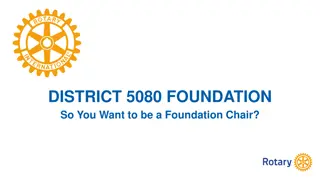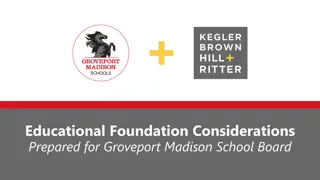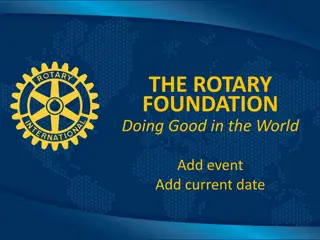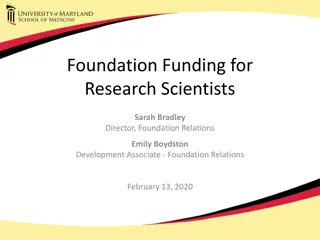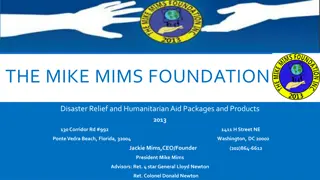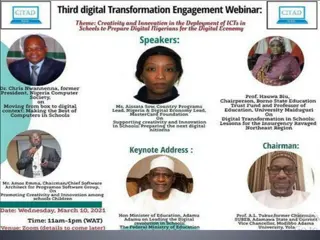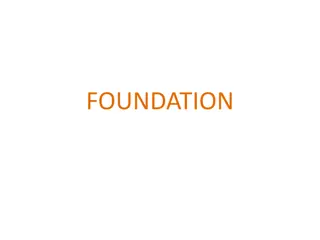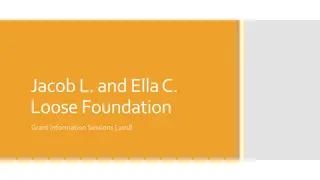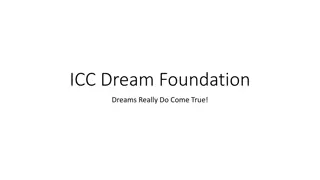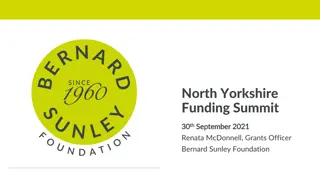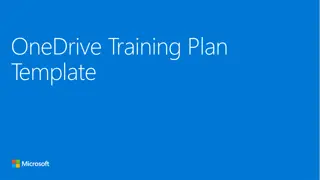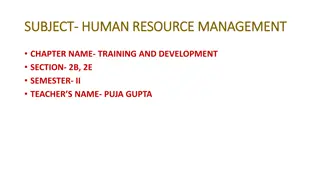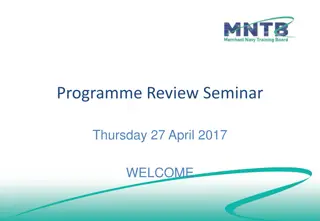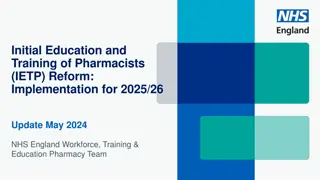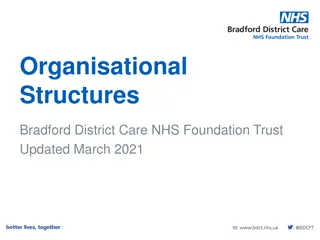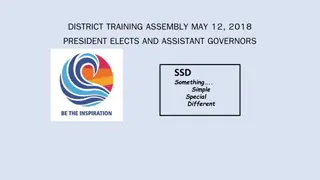Comprehensive Overview of FitSM Foundation Training in IT Service Management
This detailed content delves into the FitSM Foundation training in IT Service Management, covering topics such as basic concepts, standards, the examination process, and the qualification program. It provides insights into the importance of IT service management, the FitSM approach, and the benefits, risks, and challenges associated with implementing IT service management processes. The training agenda includes discussions on IT service management terms, concepts, general aspects, processes, and related standards and frameworks. Learn why IT service management is essential, how it aims to deliver high-quality services, and the value it brings to customers.
Download Presentation

Please find below an Image/Link to download the presentation.
The content on the website is provided AS IS for your information and personal use only. It may not be sold, licensed, or shared on other websites without obtaining consent from the author. Download presentation by click this link. If you encounter any issues during the download, it is possible that the publisher has removed the file from their server.
E N D
Presentation Transcript
FitSM Foundation Foundation training in IT Service Management according to FitSM Version 3.0.2 This work has been funded by the European Commission. It is licensed under a Creative Commons Attribution 4.0 International License. 1
Purpose of this training Become familiar with Basic IT service management concepts and terms Purpose and structure of FitSM standards and their relationship to other standards FitSM approach and key principles Process framework underlying FitSM Selected requirements defined in FitSM-1 Achieve the Foundation Certificate in IT Service Management according to FitSM 2
FitSM Foundation exam At the end of this training "Closed book exam , i.e. no aids are allowed Duration: 30 minutes 20 multiple choice questions: Four possible answers for each question: A, B, C or D One correct answer per question At least 65% correct answers (13 of 20) are required to pass the examination 3
Training agenda IT Service Management: Introduction, Terms & Concepts The FitSM Approach & Standards Family IT Service Management General Aspects IT Service Management Processes Benefits, Risks & Challenges of Implementing IT Service Management Related Standards & Frameworks 5
IT Service Management: Introduction, Terms & Concepts 6
Why IT service management is needed Why IT service management (ITSM)? Most IT outages stem from "people and process issues." Outage durations depend largely on non-technical factors. IT service management aims to deliver high quality IT services that meet customer and user expectations, and achieves this through the definition, establishment, and maintenance of service management processes. Reasons for service outages 7
Service and value Service is an intangible good that is delivered by a service provider to customers something that provides value to the customers by helping them achieve their goals. Function Quality Value How (e.g. regarding reliability, performance etc.) does a service need to delivered in order to help the customers achieve their goals? What does the service do? 8
ITSM principles: Plan-Do-Check-Act cycle (PDCA) Maturity Time Quality management approach according to W. E. Deming Key principle: continual improvement Plan-Do-Check-Act can be applied to the whole service management system 9
What is a service? Definition following FitSM-0: Service: Way to provide value to customers through bringing about results that they want to achieve Examples of IT services: Provision of standard desktop workstations Connectivity: E-Mail, LAN, internet access Provision of computational resources Provision of standard and special applications Storage, backup, archival storage Definition following FitSM-0: Service provider: Organisation or federation (or part of an organisation or federation) that manages and delivers a service or services to customers 10
What is a process? Definition following FitSM-0: Process: Set of activities that bring about a specific objective or set of results from a set of defined inputs. Key facts about ITSM processes: ITSM processes support the delivery of IT services. To provide one IT service to a customer, often several processes are needed. An IT service being successfully delivered is the result from many processes successfully operating and interacting. The ITSM processes of an IT service provider are part of the service management system (SMS). 11
Organisational structure vs. process Top management 1 Client operations Server operations Communication networks Service desk 5 2 Application servers Network planning Mobile devices DB servers Web servers 3 Network maintenance Desktop support ERP 4 CRM 12
Most important elements of a process Objectives Clearly defined inputs, triggers and outputs Activities (across different organizational units) Roles and responsibilities 13
Service management system (SMS): Overview Governance layer Top management Process owners Policy 1. Abc def ghijk. 2. Abc def ghijk. 3. Abc def ghijk. 4. Abc def ghijk. e.g. service management policy, incident handling policy Process layer Process managers Inputs Process: Activities and roles e.g. incident and service request management Outputs Operational layer Process staff Person (in a role) Procedures e.g. procedures for classifying and prioritizing incidents applies 14
Service management system (SMS): Key terms Definition following FitSM-0: Service management system (SMS): Overall management system that controls and supports management of services within an organisation or federation Definition following FitSM-0: Policy: Documented set of intentions, expectations, goals, rules and requirements, often formally expressed by top management representatives in an organisation or federation Definition following FitSM-0: Activity: Set of actions carried out within a process Definition following FitSM-0: Procedure: Specified set of steps or instructions to be carried out by an individual or team to perform one or more activities of a process 15
Service management system (SMS): Key roles Service owner: Overall responsibility for a service Maintains the service definition (in the service portfolio) Acts as primary contact point and expert for this service Process owner: Overall accountability for a process Defines process goals, monitors their fulfillment Has authority to provide / approve resources Process manager: Responsible for the operational effectiveness and efficiency of a process Reports to the process owner Process staff member: Responsible for performing a specific process activity Escalates exceptions to the process manager 16
Service management system (SMS): Key roles Overall service management system (SMS) Process owner: Processes 1 & 2 Process owner: Process 3 Pr. Manager Pr. Manager Pr. Manager Process 3 Service owner: Service 1 Process 1 Process 2 Activity 1 Activity 1 Service 1 Activity 1 Pr. staff Pr. staff Pr. staff Activity 2 Activity 2 Activity 2 Service owner: Service 2 Activity 3 Activity 3 Activity 3 Service 2 17
What is FitSM? A family of standards for lightweight IT service management Suitable for IT service providers of any type and scale Main design principle: Keep it simple! All parts (and this training material) freely available under Creative Commons licenses: www.fitsm.eu The development of the FitSM standards was supported and funded by the European Commission through the EC- FP7 project FedSM . 19
The FitSM approach The key principles of the FitSM approach to managing IT services: The foundation for systematic IT Service Management: Practicality Consistency Sufficiency Service- and customer orientation Process-orientation Continual improvement Extendibility 20
ITSM principles Principle Explanation Service- and customer-orientation IT-driven solutions provided to customers and users are arranged as services and provided according to clearly defined service levels. Services are aligned to the needs and expectations of (potential) customers. Both the service provider and customer are aware of agreed service targets. Process-orientation Activities required to plan, deliver, operate and control services are carried out as part of well-understood and effective processes. Continual improvement The entire service management system follows the plan-do-check-act approach. All processes and activities necessary to manage IT services as well as the services themselves are subject to evaluation, aimed at identifying opportunities for improvement and taking appropriate follow-up actions. 21
FitSM key principles Principle Explanation Practicality Apply simple, proven guidance instead of drowning in theoretical best practices Consistency Repeatable performance before detailed documentation Sufficiency Good enough and working over seeking the perfect solution Extendibility Leverage many sources of knowledge rather than live in a walled garden 22
FitSM parts Core standard FitSM-0 Overview & vocabulary Focus of this training FitSM-1 Requirements FitSM-2 FitSM-3 Role model Process activities and implementation Implementation aids FitSM-4 FitSM-5 FitSM-6 Templates and samples Maturity and capability level assessment scheme Implementation guides 23
FitSM process model Service Portfolio Management (SPM) Service Level Management (SLM) Service Reporting (SRM) Service Availability and Continuity Management (SACM) Capacity Management (CAPM) Information Security Management (ISM) Customer Relationship Management (CRM) Supplier Relationship Management (SUPPM) Incident and Service Request Management (ISRM) Problem Management (PM) Configuration Management (CONFM) Change Management (CHM) Release and Deployment Management (RDM) 24 Continual Service Improvement (CSI)
A possible grouping of the FitSM processes Two main topic areas: Plan and deliver Operate and control SPM SLM SRM CRM SUPPM SACM CAPM ISM CONFM CHM RDM ISRM PM CSI 25
FitSM-0: "Overview & vocabulary" FitSM-0 defines 80 important terms from the IT service management context in alphabetical order: Activity Assessment Audit Availability Availability of information Capability level Capacity Change Classification Closure Competence Confidentiality of information Conformity Configuration Configuration item (CI) Configuration management database (CMDB) Continuity Customer Demand Document Effectiveness Efficiency Emergency change Escalation Federation Federation member Federator Improvement Incident Information security Information security control Information security event Information security incident Integrity of information IT service IT service management (ITSM) Key performance indicator (KPI) Known error Major change Major incident Management review Management system Maturity level Nonconformity Operational level agreement (OLA) Operational target Policy Post implementation review (PIR) Priority Problem Procedure Process Record Release Release and deployment strategy Report Request for change Risk Role Service Service acceptance criteria (SAC) Service catalogue Service component Service level agreement (SLA) Service lifecycle Service management Service management plan Service management system (SMS) Service portfolio Service provider Service request Service review Service target Supplier Top management Underpinning agreement (UA) Underpinning contract (UC) User Value Workaround 26
FitSM-1: "Requirements" FitSM-1 defines 82 requirements that should be fulfilled by an organisation (or federation) offering IT services to customers. Compliance with the 82 requirements can be regarded as a "proof of effectiveness". The 82 requirements are structured as follows: 17 general requirements (GR) 65 process-specific requirements (PR) Consideration of the 14 IT service management processes from the FitSM process model Between 3 and 6 requirements per process 27
General aspects: Overview General aspects of a service management system (SMS) cover all topics that are not directly related to a specific ITSM process. Topics to be considered: Top Management Commitment & Accountability (MCA) Documentation (DOC) Scope & Stakeholders of IT Service Management (SCS) Planning IT Service Management (PLAN) Implementing IT Service Management (DO) Monitoring & Reviewing IT Service Management (CHECK) Continually Improving IT Service Management (ACT) 29
ITSM General aspects: Top management GR1 MCA Top management commitment & accountability: Assign one individual to be accountable for the overall SMS Define and communicate goals Define a general service management policy Conduct management reviews Documentation: Documentation to the extent necessary to support effective planning, including: General service management policy Service management plan and related process-specific plans (see GR4) Definitions of all service management processes (see PR1-PR14) Control of documentation, addressing as applicable: Creation and approval Communication and distribution Review Versioning and change tracking GR2 DOC 30
PDCA applied to the SMS: Key concepts GR3 SCS Planning IT service management: Define the scope of the SMS Set the timeline for implementing service management processes (service management plan) GR4 PLAN Implementing IT service management: Implement processes as planned Support the application and enforcement of the defined processes and procedures GR5 DO Monitoring & reviewing IT service management: Monitor key performance indicators (KPIs) to evaluate effectiveness and efficiency Perform assessments and / or (internal) audits to determine the level of compliance Assess the organisational maturity GR6 CHECK Continually improving IT service management: Identify nonconformities and deviations from goals Take action; Manage improvements through the CSI process (see PR14) GR7 ACT 31
General aspects: Summary Most important things to remember: Management buy-in is vital to the success of IT service management Serious buy-in = mandate, resources, communication! A certain level of documentation is necessary for effective processes Only write documents that someone is going to read! Embed the principles of continual improvement in the SMS, leveraging the PDCA approach 32
Service Portfolio Management (SPM) Objective To maintain the service portfolio and to manage services through their lifecycle 34
What is a service? Definition following FitSM-0: Service component: Logical part of a service that provides a function enabling or enhancing a service Note 1: A service is usually composed of several service components. Note 2: A service component is usually built from one or more configuration items (CIs). Services Service 2 Service 1 Service components SC 1 SC 2 SC 3 SC 4 SC 5 35
SPM: Important terms Definition following FitSM-0: Service portfolio: Internal list that details all the services offered by a service provider, including those in preparation, live and discontinued Definition following FitSM-0: Service lifecycle: The series of phases a service may move through in its lifetime. Note 1: Specific service lifecycle phases are typically defined for each organisation, depending on the complexity needed. These may include initial idea, proposal, design, development, deployment, production and retirement. 36
SPM: Requirements according to FitSM-1 PR1 Service Portfolio Management (SPM) REQUIREMENTS PR1.1 A service portfolio shall be maintained. All services shall be specified as part of the service portfolio. PR1.2 Proposals for new or changed services shall be evaluated based on predicted demand, required resources and expected benefits. PR1.3 The evolution of services through their lifecycle shall be managed. This shall include the planning of new services and major alterations to existing services. Plans shall consider timescales, responsibilities, new or changed technology, communication and service acceptance criteria. PR1.4 For each service, the internal and external suppliers involved in delivering the service shall be identified, including, as relevant, federation members. Their contact points, roles and responsibilities shall be determined. 37
SPM: Key concepts The service portfolio lists and defines the services that a service provider offers or plans to offer in the future. The service portfolio is an "internal tool" for the service provider. Each service in the service portfolio follows a lifecycle consisting of different phases. The transition between service lifecycle phases requires coordination 38
Service Level Management (SLM) Objective To maintain service catalogues, and to define and evaluate agreements on service quality with customers and suppliers 39
SLM: Important terms Definition following FitSM-0: Service catalogue: Customer-facing list of all live services offered along with relevant information about these services Definition following FitSM-0: Service target: Reference / target values for a parameter used to measure the performance of a service, listed in a service level agreement (SLA) related to this service Note: Typical service targets include availability or resolution time for incidents. Definition following FitSM-0: Service level agreement (SLA): Documented agreement between a customer and service provider that specifies the service to be provided and the service targets that define how it will be provided 40
SLM: Important terms Definition following FitSM-0: Operational level agreement (OLA) Agreement between a service provider or federation member and another part of the service provider s organisation or the federation to provide a service component or subsidiary service needed to allow provision of services to customers Definition following FitSM-0: Underpinning agreement (UA) Documented agreement between a service provider and an external supplier that specifies the underpinning service(s) or service component(s) to be provided by the supplier, and the service targets that define how it will be provided Note: A UA can be seen as a service level agreement (SLA) with an external supplier where the service provider is in the customer role. 41
SLM: Requirements according to FitSM-1 PR2 Service Level Management REQUIREMENTS PR2.1 A service catalogue shall be maintained. PR2.2 For all services delivered to customers, service level agreements (SLAs) shall be in place and reviewed at planned intervals. PR2.3 Service performance shall be evaluated against service targets defined in SLAs. PR2.4 For supporting services or service components, underpinning agreements (UAs) and operational level agreements (OLAs) shall be agreed as needed and reviewed at planned intervals. PR2.5 Performance of supporting services and service components shall be evaluated against targets defined in UAs and OLAs. 42
SLM: Key concepts Service catalogue(s) While the service portfolio is an "internal tool" for the service provider, the service catalogue(s) is (are) facing the customer. The service portfolio is the basis for any service catalogue. Service catalogue(s) Service portfolio basis for Customer 43
SLM: Key concepts Types of service agreements and their relationships Customer Service level agreements (SLAs) Service C Service B Service A (IT) service provider Service components Operational level agreements (OLAs) Underpinning agreements (UAs) Internal groups or federation members Suppliers 44
SLM: Key concepts and activities The information that SLAs provide (e.g. service targets) is vital as a basis for the execution of many other processes. Key activities Producing a service catalogue for the customers and agreeing SLAs with customers. Agreeing OLAs and UAs with supporting parties and suppliers to ensure service targets in SLAs can be met. Evaluating service performance based on SLAs. 45
Service Reporting Management (SRM) Objective To specify reports on services and processes and ensure they are produced and delivered 46
SRM: Requirements according to FitSM-1 PR3 Service Reporting REQUIREMENTS PR3.1 Required reports shall be identified. Reporting shall cover performance of services and processes against defined targets, significant events and detected nonconformities. PR3.2 Reports shall be agreed with their recipients and specified. The specification of each report shall include its identity, purpose, audience, frequency, content, format and method of delivery. PR3.3 Reports shall be produced and delivered to their recipients according to specifications. 47
SRM: Important terms Definition following FitSM-0: Report: A structured record communicating results gathered through measurement, monitoring, assessment, audit or observation Note: A common report generated from a service management system is a service report targeted to customers of a service that details the performance of that service versus the service targets defined in a service level agreement (SLA). 48
SRM: Key concepts and activities Reports are important to support decision-making. Reports can be useful to demonstrate the level of service quality that has been achieved. Reports agreed with customers are often set out in Service Level Agreements (SLAs) Key activities Specifying and agreeing the reports and their purpose, audience, frequency, content, format and method of delivery with the report stakeholders / recipients. Controlling the creation delivery of reports 49
Service Availability & Continuity Management (SACM) Objective To ensure sufficient service availability and continuity to meet service targets 50
